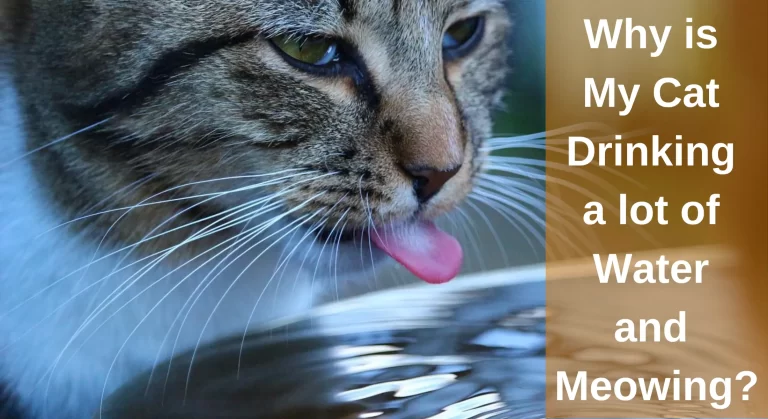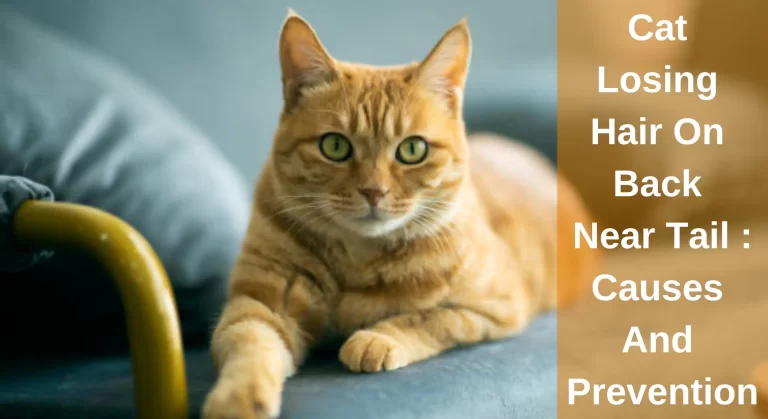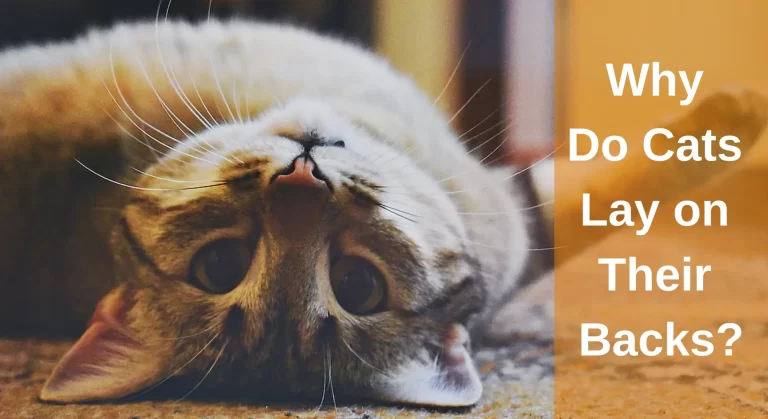The Ultimate Guide to How to Make a Cat and Dog Get Along? (Unlocking the Secret)
Bringing a cat and dog together under one roof may seem like a recipe for disaster, with visions of fur-flying fights and constant barking. However, contrary to popular belief, cats and dogs can actually get along harmoniously and even form strong bonds. “Cat and Dog Get Along”
While they have different personalities and behaviors, it is possible for them to form a harmonious relationship with proper introductions and ongoing management. The key is to provide a gradual and controlled introduction process, allowing them to become familiar with each other’s scents and presence. It’s important to be patient and give them time to adjust to each other. With patience, consistent training, and positive reinforcement, cats, and dogs can coexist and even develop strong bonds, bringing joy and companionship to the household.
In this article, we’ll explore the dynamics of cat-dog relationships, provide practical tips for introducing them, discuss signs of a healthy relationship, address common challenges, and highlight the benefits of having both furry friends.
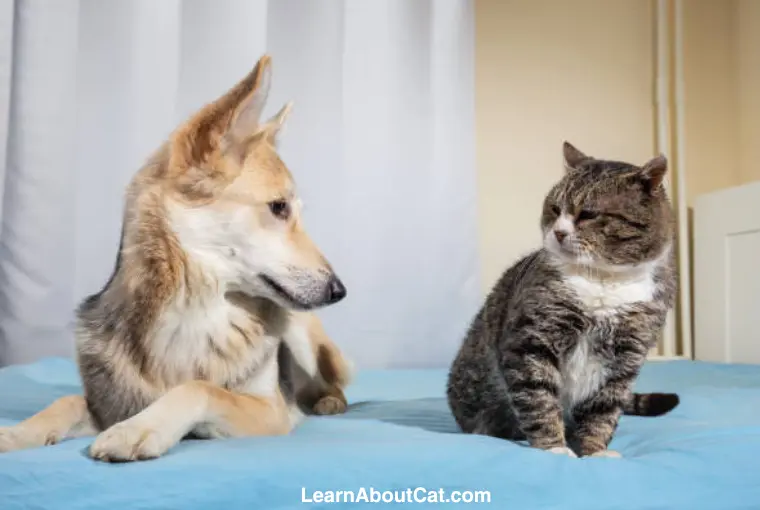
The Myth of Cats and Dogs as Natural Enemies
For generations, cats and dogs have been portrayed as natural enemies in popular culture. From cartoons to movies, the idea of cats hissing at dogs and dogs chasing cats has become deeply ingrained in our collective consciousness. However, the truth is that this depiction is more fiction than reality. While cats and dogs may have different instincts and social behaviors, they are capable of forming meaningful relationships if given the opportunity.
Can Cats and Dogs Live in the Same Household?
The age-old question of whether cats and dogs can live together harmoniously in the same household has been a topic of debate.
Absolutely! Cats and dogs can indeed live in the same household and form wonderful relationships with each other. While it may require some initial adjustments and careful introductions, many cats and dogs coexist peacefully and even develop close bonds. Here are a few key factors to consider:
Factors that Influence Cat-Dog Relationships
Several factors play a crucial role in determining how well cats and dogs get along. Understanding these factors can help pet owners set the stage for a positive and harmonious relationship.
- Individual personality and temperament: The unique traits and characteristics of each pet impact their compatibility. Matching compatible personalities can greatly increase the chances of a successful cat-dog relationship.
- Early socialization: Positive interactions during the early stages of development contribute to better relationships. Puppies and kittens that grow up together tend to have an easier time accepting and understanding each other’s behaviors.
- Previous experiences: Past encounters with other animals can shape a pet’s behavior and attitude towards the opposite species.
- Species-specific behaviors: Understanding the natural behaviors and communication styles of cats and dogs helps facilitate their interactions.
Check Out: How Long Can You Leave a Cat Alone Safely? Things You Need To Know
How to Make a Cat and Dog Get Along?
Introducing a cat to a dog, or vice versa, requires careful planning and a gradual approach to ensure a smooth transition and the establishment of a positive relationship. Both cats and dogs have their own unique behaviors and instincts, and introducing them properly can set the foundation for harmonious coexistence.
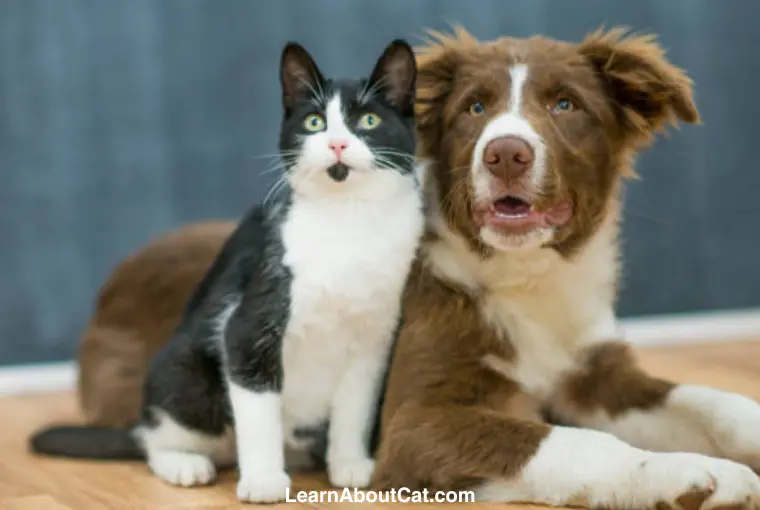
1. Prepare a Separate Space
Before the actual introduction, it is essential to set up a separate space for each pet. This includes separate rooms or areas where they can retreat to feel safe and have their own resources. Cats should have access to litter boxes, scratching posts, and hiding spots, while dogs should have their own bed, toys, and food and water bowls.
Cats often prefer vertical spaces, such as cat trees or shelves, where they can observe from a height. Dogs, on the other hand, should have their own designated area with a bed, toys, and food and water bowls. These separate spaces ensure that both pets have a place to relax and escape from any potential stress or conflict.
This ensures that each pet has its own territory and reduces the chances of conflicts over resources.
2. Gradual Scent Exchange
The first step in introducing a cat to a dog is to allow them to become familiar with each other’s scent. Start by swapping bedding or toys between the two animals. This helps them associate the other’s scent with something positive and familiar. Gradually, introduce them to each other’s scent by rubbing a cloth on one pet and placing it near the other. This gradual scent exchange helps them become accustomed to each other’s presence without direct contact.
3. Controlled Visual Contact
Once they have become familiar with each other’s scent, it’s time to allow controlled visual contact. Use a baby gate or a door crack to separate the two animals while allowing them to see each other. This visual introduction helps them gauge each other’s body language and behavior without the risk of direct confrontation.
Observe their reactions closely and look for signs of stress, fear, or aggression. If either pet becomes too anxious or agitated, slow down the process and give them more time to adjust.
4. Leashed Face-to-Face Introduction
When both the cat and dog seem comfortable with the visual contact, it’s time for a face-to-face introduction while keeping them on a leash or harness. Choose a neutral space where neither pet feels territorial, such as a room they haven’t spent much time in. Allow them to approach each other at their own pace while maintaining control of the leash and closely monitoring their behavior.
Reward calm and friendly interactions with treats and praise, reinforcing positive associations. Supervision is crucial during these interactions to prevent any potential conflicts.
5. Gradual Unleashed Interaction
If the initial face-to-face introduction goes well, you can gradually progress to unleashed interactions under close supervision. Allow short periods of supervised interaction between the cat and dog, gradually increasing the duration as they become more comfortable with each other.
Continue rewarding positive behavior and intervening if any signs of aggression or fear arise. Be patient, as it may take time for them to establish a bond and become fully comfortable with each other’s presence.
6. Safety Measures
During the introduction process, it’s important to prioritize safety for both the cat and the dog. Ensure that the cat has access to high perches or hiding spots where they can retreat if they feel overwhelmed. Keep the dog’s excitement and energy level in check, as excessive enthusiasm can intimidate the cat.
Avoid forcing interactions or overwhelming either pet with too much stimulation. Always supervise their interactions, especially during the initial stages of introduction.
7. Gradual Progression
Remember that each cat-dog introduction is unique, and the timeline for success may vary. Some cats and dogs may form a bond quickly, while others may require more time and patience. It’s crucial to progress at a pace that suits both pets’ comfort levels. Avoid rushing the process and allow them to set their own pace.
Be patient and provide plenty of positive reinforcement and encouragement along the way. If any signs of aggression or extreme stress persist, consult with a professional animal behaviorist or trainer for guidance and support.
8. Positive Reinforcement
Positive reinforcement is a powerful tool in helping your cat and dog associate each other’s presence with positive experiences. Reward them with treats, praise, and affection whenever they display calm and friendly behavior toward each other.
This helps create positive associations and encourages them to view each other in a positive light. Consistency is key, so be sure to reinforce positive behavior every time they interact peacefully.
Signs of a Healthy Cat-Dog Relationship
When cats and dogs establish a healthy relationship, it can be a joy to witness their interactions and the bond that forms between them. While every cat-dog relationship is unique, there are certain signs that indicate a positive and harmonious connection between the two.
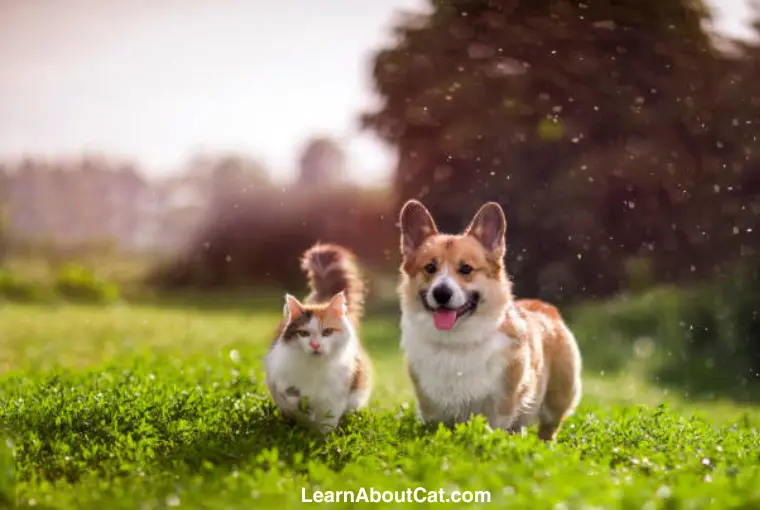
1. Mutual Curiosity and Interest
A healthy cat-dog relationship is characterized by a mutual curiosity and interest in each other. Both pets may show curiosity by sniffing, observing, and even following each other around. They may engage in playful behaviors, such as chasing or batting at each other, without any signs of aggression or fear. This genuine interest in each other’s presence and activities is a positive indicator of a healthy relationship.
2. Playful Interactions
Play is an essential component of a healthy cat-dog relationship. When cats and dogs engage in playful interactions, it shows that they feel comfortable and enjoy each other’s company. They may engage in chasing games, gentle wrestling, or batting at each other’s paws.
Playful interactions are typically balanced, with both pets taking turns initiating and reciprocating play. It’s important to ensure that the play remains gentle and does not escalate into aggression.
In a healthy cat-dog relationship, cats and dogs feel comfortable sharing spaces and engaging in common activities. They may choose to relax in the same room, sleep close to each other, or even groom each other. Shared activities, such as eating, playing, or exploring together, indicate a level of trust and acceptance between the two pets.
It’s a positive sign when both pets willingly share their resources and enjoy each other’s company.
4. Calm Coexistence
A healthy cat-dog relationship is characterized by a calm and relaxed coexistence. Both pets can be in close proximity to each other without tension or stress. They may choose to nap or lounge in the same area without displaying signs of aggression or avoidance.
Cats and dogs in a healthy relationship may even seek comfort and companionship from each other during times of stress or anxiety.
5. Respect for Boundaries
Respecting each other’s boundaries is a vital aspect of a healthy cat-dog relationship. Both pets understand and acknowledge when the other needs space or prefers not to be interacted with. They give each other the freedom to retreat to their designated safe spaces when needed, without displaying territorial or possessive behaviors.
This respect for boundaries fosters a sense of security and trust between the cat and the dog.
6. Positive Body Language
Observing their body language can provide valuable insights into the dynamics of a cat-dog relationship. In a healthy relationship, both pets exhibit relaxed and non-threatening body postures. They may approach each other with a loose and wagging tail (for dogs) or a relaxed and upright tail (for cats).
Ears are typically in a neutral position, and there is no visible tension or raised fur. Positive body language signifies a level of comfort and ease in their interactions.
7. Emotional Well-being
A healthy cat-dog relationship contributes to the emotional well-being of both pets. They may show signs of contentment, such as purring (for cats) or wagging their tail (for dogs), when in each other’s presence. Both pets exhibit overall positive behavior, eat well, and maintain their normal routines.
They show minimal signs of stress, fear, or anxiety in the presence of the other. The emotional well-being of both pets is a key indicator of a healthy relationship.
Common Challenges and How to Overcome Them in a Cat-Dog Relationship
Introducing a cat and a dog into the same household can come with its fair share of challenges. While it’s possible for them to develop a harmonious relationship, there are certain obstacles that may arise along the way.
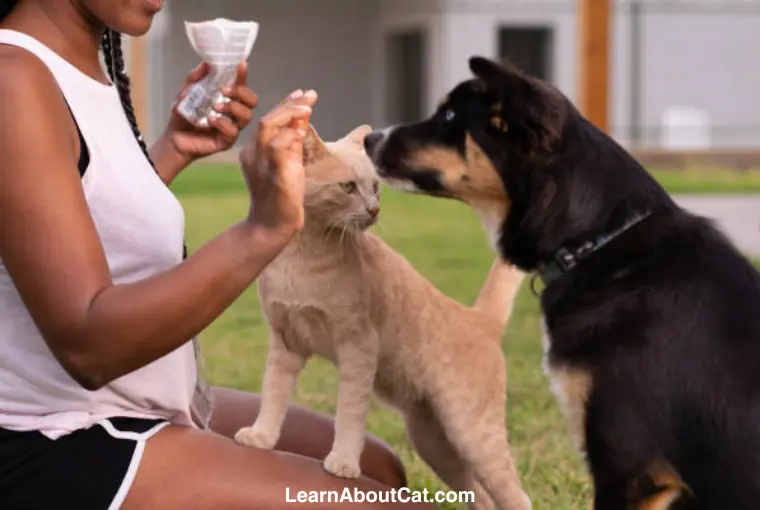
1. Predatory Instincts– Chasing Behavior
One of the primary challenges in a cat-dog relationship is the dog’s natural predatory instincts towards cats. Dogs, especially those with a strong prey drive, may be inclined to chase or even harm cats. To overcome this challenge, it’s crucial to provide proper training and socialization for your dog.
Teach them basic commands such as “sit,” “stay,” and “leave it.” Gradually introduce your dog to the presence of cats through controlled visual and scent interactions, rewarding calm behavior. Supervised exposure and positive reinforcement can help diminish the dog’s prey drive and create a safer environment for both pets.
2. Fear and Aggression
Fear and aggression can arise in both cats and dogs when they feel threatened or overwhelmed. Cats may scratch or hiss, while dogs may bark, growl, or lunge. These behaviors can escalate the tension between the two pets. To address fear and aggression, it’s essential to create positive associations and desensitize them to each other’s presence. Use treats, praise, and rewards to reinforce calm behavior.
Gradually increase their exposure to each other, starting with brief and supervised interactions. Consult with a professional animal behaviorist or trainer if the fear or aggression persists, as they can provide specialized guidance and techniques to manage and overcome these challenges.
3. Territorial Issues
Cats are naturally territorial creatures, and the introduction of a new dog can disrupt their sense of territory and security. Cats may mark their territory with urine, exhibit defensive behaviors, or hideaway. To address territorial issues, provide your cat with their own safe and separate spaces where it can retreat and feel secure. Ensure they have access to vertical spaces, such as cat trees or shelves, where they can observe from a height.
Gradual introductions and positive reinforcement can help alleviate territorial concerns over time. Additionally, providing plenty of environmental enrichment, such as interactive toys and scratching posts, can help redirect their focus and reduce territorial behaviors.
4. Unequal Energy Levels
Dogs and cats often have different energy levels and play styles. Dogs may be more active and boisterous, while cats prefer a more relaxed and independent approach. This difference in energy levels can lead to misunderstandings and conflicts. To overcome this challenge, provide both pets with ample exercise and mental stimulation. Engage your dog in regular walks, play sessions, and training exercises to help burn off excess energy.
Offer interactive toys and playtime for your cat to keep them mentally and physically stimulated. By addressing their individual needs, you can help balance their energy levels and prevent frustration or excessive chasing behaviors.
5. Resource Guarding
Resource guarding occurs when a pet becomes possessive of certain items, such as food, toys, or sleeping areas. This can lead to conflicts between a cat and a dog if one pet feels threatened or intimidated. To manage resource guarding, ensure that each pet has their own designated areas for eating, resting, and playing. Feed them in separate spaces to prevent competition or aggression.
Gradually introduce shared spaces and resources under supervision, rewarding calm and non-possessive behavior. If resource guarding becomes a persistent issue, consult with a professional trainer or behaviorist who can provide specialized guidance and training techniques.
The Benefits of Having Both Cats and Dogs
Having both cats and dogs as pets can bring a unique and enriching experience to your life. While cats and dogs have different personalities and behaviors, their presence together can offer numerous benefits. In this article, we will explore the advantages of having both cats and dogs as part of your household.
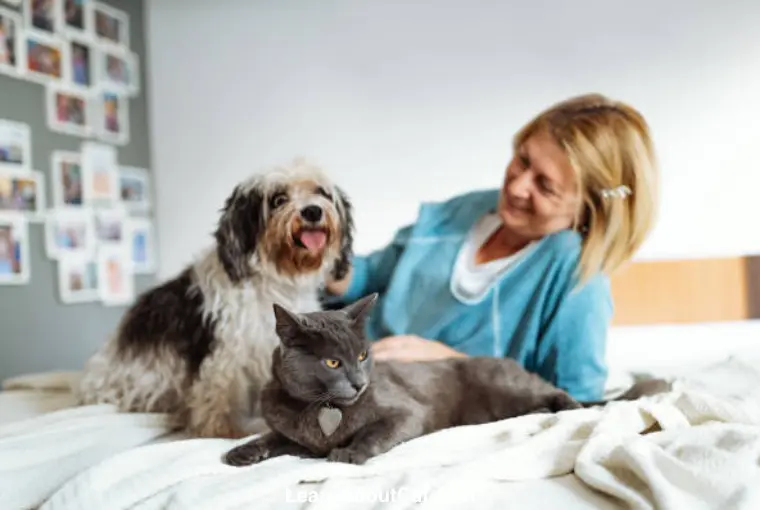
1. Companionship and Emotional Support
Cats and dogs are known for their ability to provide companionship and emotional support to their owners. Cats are often cherished for their independent nature and calm demeanor, while dogs are admired for their loyalty and affection. When you have both cats and dogs, you can experience the best of both worlds.
Cats can offer a sense of tranquility and relaxation, while dogs can bring energy and enthusiasm. Their distinct personalities complement each other, providing a diverse range of emotional support for you and your family.
2. Increased Physical Activity
Dogs, by nature, require regular exercise and physical activity to maintain their health and happiness. When you have a dog, you are more likely to engage in activities such as daily walks, playing fetch, or even participating in dog sports. Cats, on the other hand, are generally more sedentary and independent.
However, the presence of a dog can inspire your cat to become more active. They may engage in playful chases, and interactive toys, or even join in on a game of hide-and-seek. The combined presence of cats and dogs can encourage a more active lifestyle for both pets and their owners.
4. Stress Reduction
The presence of pets, whether cats or dogs, has been shown to reduce stress levels in humans. The gentle purring of a contented cat or the warm presence of a dog lying by your side can provide a calming effect. Having both cats and dogs in your home doubles the opportunity for stress reduction. Cats are known for their soothing purrs, which can have a therapeutic effect on your well-being.
Dogs, with their affectionate nature, provide comfort and a sense of security. The combined presence of these animals can create a harmonious and stress-free environment in your home.
5. Complementary Caretaking
Caring for both cats and dogs requires different approaches and responsibilities. Cats are generally more independent and have lower maintenance needs. They are meticulous groomers and often require less attention in terms of exercise and training. Dogs, on the other hand, require regular exercise, training, and social interaction.
By having both cats and dogs, you can experience the joy of nurturing different needs and providing a well-rounded caregiving experience. This variety can bring fulfillment and a sense of purpose to your role as a pet owner.
Frequently Asked Questions
Can all cats and dogs be trained to get along?
While most cats and dogs can eventually learn to coexist peacefully, individual personalities and past experiences can influence the process. With proper introduction and training techniques, the chances of success are significantly higher.
How long does it take for a cat to get used to a dog?
The time required for cats and dogs to adjust varies depending on their personalities and previous experiences. It can take anywhere from a few weeks to several months for them to develop a comfortable relationship.
What if my cat and dog still don’t get along after following these steps?
If your cat and dog continue to have difficulty getting along, it’s advisable to seek professional assistance from an animal behaviorist. They can assess the situation and provide specialized guidance based on your pets’ specific needs.
Can I introduce an adult cat and dog to each other?
Yes, adult cats and dogs can be introduced to each other successfully. However, the process may require more time and patience compared to introducing kittens and puppies. Follow the gradual introduction steps and closely monitor their behavior throughout the process.
Wrap Up!
Cats and dogs can indeed live together in the same household. While their differences in behavior and communication styles may present initial challenges, with proper introductions and ongoing management, they can develop a harmonious relationship. Patience, time, and consistent training are key to helping them adapt to each other’s presence. By providing separate safe spaces, gradual introductions, and positive reinforcement, cats, and dogs can coexist and even form strong bonds, bringing joy and companionship to the household.
Remember, each pet is unique, and the process may vary, but with love and understanding, a happy and balanced coexistence is possible between cats and dogs.
Related Posts:
Who is Isabella?
My name is Isabella, and I am a dedicated and knowledgeable cat enthusiast. With years of experience caring for cats and a deep love for felines, I made a mission to help other cat lovers navigate the challenges of cat ownership.



